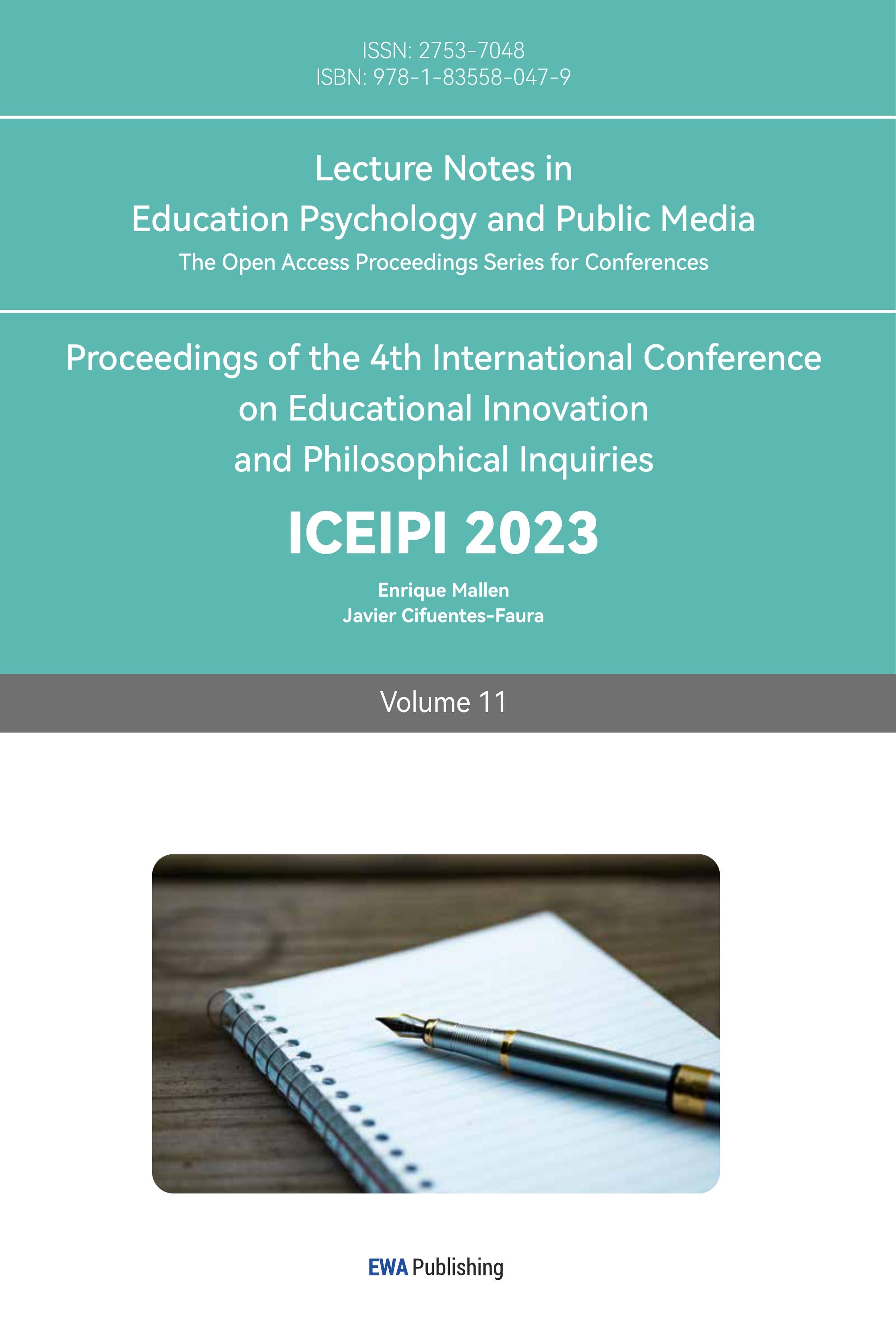References
[1]. Stein, D. J., Costa, D., Lochner, C., Miguel, E. C., Reddy, Y., Shavitt, R. G., van den Heuvel, O. A., & Simpson, H. B. (2019). Obsessive-compulsive disorder. Nature reviews. Disease primers, 5(1), 52.
[2]. Darvishi, E., Golestan, S., Demehri, F., & Jamalnia, S. (2020). A cross-sectional study on cognitive errors and obsessive-compulsive disorders among young people during the outbreak of coronavirus disease 2019. Activitas Nervosa Superior, 62(4), 137-142.
[3]. Mathes, B. M., Morabito, D. M., & Schmidt, N. B. (2019). Epidemiological and Clinical Gender Differences in OCD. Current psychiatry reports, 21(5), 36.
[4]. Ruscio, A. M., Stein, D. J., Chiu, W. T., & Kessler, R. C. (2010). The epidemiology of obsessive-compulsive disorder in the National Comorbidity Survey Replication. Molecular psychiatry, 15(1), 53-63.
[5]. Chaudhary, R. K., Kumar, P., & Mishra, B. P. (2016). Depression and risk of suicide in patients with obsessive-compulsive disorder: A hospital-based study. Industrial psychiatry journal, 25(2), 166.
[6]. Ferreira, S., Couto, B., Sousa, M., Vieira, R., Sousa, N., Picó-Pérez, M., & Morgado, P. (2021). Stress influences the effect of obsessive-compulsive symptoms on emotion regulation. Frontiers in psychiatry, 11, 594541.
[7]. Gaikwad, U. (2014). Pathophysiology of obsessive-compulsive disorder: affected brain regions and challenge towards discovery of novel drug treatment. Obsessive-Compulsive Disorder-The Old and the New Problems.
[8]. Thorsen, A. L., Hagland, P., Radua, J., Mataix-Cols, D., Kvale, G., Hansen, B., & van den Heuvel, O. A. (2018). Emotional processing in obsessive-compulsive disorder: a systematic review and meta-analysis of 25 functional neuroimaging studies. Biological Psychiatry: Cognitive Neuroscience and Neuroimaging, 3(6), 563-571.
[9]. Cludius, B., Mannsfeld, A. K., Schmidt, A. F., & Jelinek, L. (2021). Anger and aggressiveness in obsessive–compulsive disorder (OCD) and the mediating role of responsibility, non-acceptance of emotions, and social desirability. European archives of psychiatry and clinical neuroscience, 271(6), 1179-1191.
Cite this article
Zhu,J. (2023). Research on the Characteristics of Emotion Regulation in Obsessive-Compulsive Disorder. Lecture Notes in Education Psychology and Public Media,11,233-237.
Data availability
The datasets used and/or analyzed during the current study will be available from the authors upon reasonable request.
Disclaimer/Publisher's Note
The statements, opinions and data contained in all publications are solely those of the individual author(s) and contributor(s) and not of EWA Publishing and/or the editor(s). EWA Publishing and/or the editor(s) disclaim responsibility for any injury to people or property resulting from any ideas, methods, instructions or products referred to in the content.
About volume
Volume title: Proceedings of the 4th International Conference on Educational Innovation and Philosophical Inquiries
© 2024 by the author(s). Licensee EWA Publishing, Oxford, UK. This article is an open access article distributed under the terms and
conditions of the Creative Commons Attribution (CC BY) license. Authors who
publish this series agree to the following terms:
1. Authors retain copyright and grant the series right of first publication with the work simultaneously licensed under a Creative Commons
Attribution License that allows others to share the work with an acknowledgment of the work's authorship and initial publication in this
series.
2. Authors are able to enter into separate, additional contractual arrangements for the non-exclusive distribution of the series's published
version of the work (e.g., post it to an institutional repository or publish it in a book), with an acknowledgment of its initial
publication in this series.
3. Authors are permitted and encouraged to post their work online (e.g., in institutional repositories or on their website) prior to and
during the submission process, as it can lead to productive exchanges, as well as earlier and greater citation of published work (See
Open access policy for details).
References
[1]. Stein, D. J., Costa, D., Lochner, C., Miguel, E. C., Reddy, Y., Shavitt, R. G., van den Heuvel, O. A., & Simpson, H. B. (2019). Obsessive-compulsive disorder. Nature reviews. Disease primers, 5(1), 52.
[2]. Darvishi, E., Golestan, S., Demehri, F., & Jamalnia, S. (2020). A cross-sectional study on cognitive errors and obsessive-compulsive disorders among young people during the outbreak of coronavirus disease 2019. Activitas Nervosa Superior, 62(4), 137-142.
[3]. Mathes, B. M., Morabito, D. M., & Schmidt, N. B. (2019). Epidemiological and Clinical Gender Differences in OCD. Current psychiatry reports, 21(5), 36.
[4]. Ruscio, A. M., Stein, D. J., Chiu, W. T., & Kessler, R. C. (2010). The epidemiology of obsessive-compulsive disorder in the National Comorbidity Survey Replication. Molecular psychiatry, 15(1), 53-63.
[5]. Chaudhary, R. K., Kumar, P., & Mishra, B. P. (2016). Depression and risk of suicide in patients with obsessive-compulsive disorder: A hospital-based study. Industrial psychiatry journal, 25(2), 166.
[6]. Ferreira, S., Couto, B., Sousa, M., Vieira, R., Sousa, N., Picó-Pérez, M., & Morgado, P. (2021). Stress influences the effect of obsessive-compulsive symptoms on emotion regulation. Frontiers in psychiatry, 11, 594541.
[7]. Gaikwad, U. (2014). Pathophysiology of obsessive-compulsive disorder: affected brain regions and challenge towards discovery of novel drug treatment. Obsessive-Compulsive Disorder-The Old and the New Problems.
[8]. Thorsen, A. L., Hagland, P., Radua, J., Mataix-Cols, D., Kvale, G., Hansen, B., & van den Heuvel, O. A. (2018). Emotional processing in obsessive-compulsive disorder: a systematic review and meta-analysis of 25 functional neuroimaging studies. Biological Psychiatry: Cognitive Neuroscience and Neuroimaging, 3(6), 563-571.
[9]. Cludius, B., Mannsfeld, A. K., Schmidt, A. F., & Jelinek, L. (2021). Anger and aggressiveness in obsessive–compulsive disorder (OCD) and the mediating role of responsibility, non-acceptance of emotions, and social desirability. European archives of psychiatry and clinical neuroscience, 271(6), 1179-1191.









